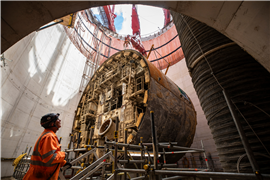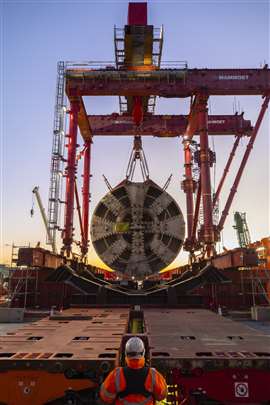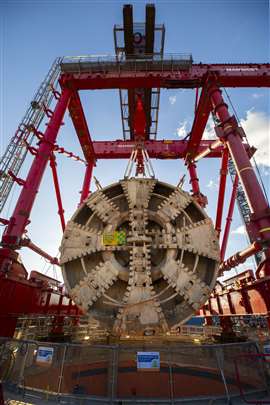Read this article in Français Deutsch Italiano Português Español
Custom lifting gantry aids TBM removal
30 September 2025
A custom-built gantry system was deployed to remove tunnel boring machines on the HS2 rail project in the UK. Alex Dahm reports
 Going up: one of the TBM sections being lifted out of a vent shaft. Photo: Mammoet
Going up: one of the TBM sections being lifted out of a vent shaft. Photo: Mammoet
Working at ground level is preferred to working at height and the same applies to working under ground. Dismantling large underground machinery is easier and safer if you can do it at ground level.
Demand for larger diameter tunnels means the tunnel boring machines to dig them are also much bigger. In turn, they are more difficult to remove when they have finished their work.
Getting them out of the ground can be a significant challenge, particularly in urban, built-up areas, according to global heavy lift and transport specialist Mammoet.
Mammoet met this challenge on a job to remove TBMs made by Herrenknecht when they had finished excavating tunnels for the UK’s High Speed 2 (HS2) rail construction project between Birmingham and London.
Four TBMs had to be removed on the outskirts of London. Working with the construction contractor Skanska Costain Strabag Joint Venture (SCSJV) and Herrenknecht, Mammoet came up with a custom gantry solution to do the job more quickly and safely.
 One of the head sections of the TBMs being lowered onto the saddles on the SPMT prior to transport to another area of the site for further dismantling. Photo: Mammoet
One of the head sections of the TBMs being lowered onto the saddles on the SPMT prior to transport to another area of the site for further dismantling. Photo: Mammoet
Time benefits
Allowing the TBM to be removed in one piece gave several advantages.It saved time and reduced risk because less dismantling work was needed below ground. Sections of the TBM were removed in one day instead of it taking weeks.
The four TBMs excavated the 8.4 mile (14 km) Northolt Tunnel section. Two went in each way, digging a pair of tunnels from both ends towards each other. They met in the middle at the Green Park Way vent site where there are two vertical shafts, 35 metres above the tunnel bores.
Mammoet planned to remove the biggest components – the cutter head with the front and middle shields – in one lift. That way they’d not need to be taken apart before lifting.
The site was in a busy city near two existing live railway lines and other civils work was ongoing close by. “Different approaches were considered at the start,” says Darren Watson, Mammoet sales director.
“One option was that the TBMs would be split and disassembled within the shaft and the component parts lifted out by a crane. However, this would have meant people working down there in a very congested space, with ventilation issues to overcome and a large crane taking up a significant portion of the compound area above, interfering with other works on site,” Watson continued.
Complete sections
It was the specially designed and built gantry system that allowed the sections to be brought up in one piece before loading them onto self propelled modular transporter (SPMT) for dismantling and removal from site.
Considerable time and effort went into the gantry system. Design work started nine months before to execution. Once approved, it went into a detailed engineering phase of five months. The gantry was then constructed on site over a period of one month.
Gantry systems can be assembled in a multitude of combinations, typically using a mix of standard and custom components. In this application it was assembled in a new configuration with the addition of fabricated parts to allow it to lift 900 tonnes.
A hydraulic skidding system carried the gantry, allowing forwards and backwards movement, to position it above the openings of the two vent shafts. An equaliser beam incorporating a swivel allowed everything to be moved to a central point. The lifted components could then be rotated.
“Normally, if that was any other piece of equipment, you would have to attach another system and exert external force onto the load to turn it. This would require a lot of manual handling. We created a system that could be remote controlled for ease of operation,” explains Sam Ellwood, Mammoet lead engineer.
“This avoided us having to use taglines and winches – and besides, we would have had to get close to the load to attach items to it. Our solution allowed us to be ‘hands off’, so that everything could be kept isolated. This made for a safer operation.”
Rail restrictions
 The largest sections of the tunnel boring machines could be extracted faster using the custom gantry system and then dismantled at ground level. Photo: Mammoet
The largest sections of the tunnel boring machines could be extracted faster using the custom gantry system and then dismantled at ground level. Photo: Mammoet
Being able to move the load in this way was vital for lifting out of one of the vent shafts as part of it was underneath the neighbouring rail line. In addition, the new HS2 line runs parallel to that track but the skidding system track couldn’t so the load had to be turned slightly as it was coming up out of the hole to get it pointing the right way to be skidded.
When the TBM pieces had been lifted out of the ground the lifting gantry was repositioned over 32 axle lines of SPMT in two columns standing between the skid tracks. The TBM sections were carried in a steel cradle to a disassembly area on the site. They were lowered to the ground using climbing jack and taken apart. Doing it this way meant less work at height when removing the hydraulic rams, drive motors and so on from inside.
Commenting on the project Richard Dexter, Herrenknecht International managing director, said, “The two- and, more widely, four- site teams had to erect and commission the system at the start of the year, and then, several months later, co-ordinate lifting in twelve-hour windows during weekend railway possessions.
“The total works needed four 24-hour lift and carry operations. These were, in turn, based upon four week-long preparations, two month-long assemble and disassemble periods and eight months of intense engineering, design, planning, structural analysis, materials and weld testing – as well as possessions and community engagement.”
In summary Dexter said, “It has been one of the smoothest real-time demonstrations of relationships developed over many years, brought into play to solve a considerable challenge.
“Together, all the teams yielded large time savings for the project, in the form of early access for follow-on tasks of several months in each of the four tunnels.”
STAY CONNECTED



Receive the information you need when you need it through our world-leading magazines, newsletters and daily briefings.
CONNECT WITH THE TEAM











